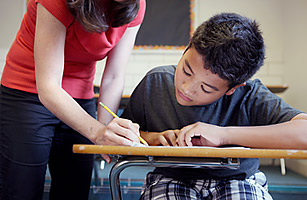
A newly released report on student achievement finds that members of the nation’s second largest ethnic group are still woefully underperforming their white counterparts. The report, issued June 23 by the U.S. Department of Education’s National Center for Education Statistics shows that while scores have gone up for both groups, Hispanic students lag by the same amount today as they did in 1990, which means that the achievement gap between Hispanic and white students has been largely unchanged for the past two decades.
The report analyzes tests given to fourth and eighth graders in math and reading in 2009. Overall, on a national level, Hispanic students scored about 20 points — or two whole grade levels — lower on the National Assessment of Educational Progress scale.
Those stats are especially worrisome seeing as the Hispanic population in the U.S. is only going to continue to grow. In the past 40 years, to take just the nation’s fourth graders, the Hispanic student population has increased from less than 2% to 21%. That growth is consistent with the 2010 Census, which shows that the Hispanic population in the U.S. has boomed to 16% of the total population and is expected to rise to 30% by 2050. “As the Hispanic population grows, closing the achievement gap is critical to ensure our future as a nation and our ability to compete worldwide,” said Russ Whitehurst, director of the Brown Center on Education Policy at the Brookings Institution. “We can’t afford to ignore this problem.”
Although the report focuses on the achievement of an entire ethnic group, the numbers suggest that the persistent gap has more to do with the language barrier among a subset of that group. There are some four million Hispanic students in public schools whose primary language is not English. The NCES report showed an even larger difference between those students, known as English language learners or ELL, and their Hispanic classmates who are proficient in English. For example, in eighth grade reading, the discrepancy between ELL Hispanic students and non-ELL Hispanic students was 39 points, or roughly four whole grade levels.
Three states — California, Connecticut and Rhode Island — had larger achievement gaps between Hispanic and white students than the national gap in both math and reading at both the 4th and 8th grade level. That finding is especially disconcerting for California, which ties with Texas for having the second-largest Hispanic population in the nation. For their part, California’s Department of Education maintains that closing the achievement gap is a top priority. “The long-standing achievement gap is a matter of deep concern,” said State Schools Chief Tom Torlakson, in a statement released to TIME on the eve of the NCES report’s release. “We also are moving quickly to reexamine our efforts to make sure these students succeed.”
Other states fared better. Arkansas, Florida, Georgia, Kentucky, Missouri, Oklahoma and Wyoming all had smaller achievement gaps in both grades and both subjects. Florida is the success stories everyone points to. The state has one of the very highest Hispanic populations in the nation, yet 31% of their Hispanic students score proficient or better on the test. Florida’s Public Schools Chancellor Michael Grego attributes their success to rigorous standards for all students, teacher training focused on instructing non-English speakers and programs such as dual language classes where English speakers learn Spanish and vice versa. “The reality of it is, as public educators, we need to educate whoever comes through the door. So if 35% of your students are Hispanic, you have to address their needs,” Grego told TIME.
Rigorous curricula may be another key ingredient missing from some Hispanic-focused programs. Kati Haycock, president of the national policy group Education Trust, has said many times that disadvantaged students are not expected to perform well. As a consequence, they only reach the low bar set for them rather than being pushed to a high level. “Look at what is being asked of kids who are poor, Latino or black,” Haycock told TIME. “They have shockingly low expectations. Until we get serious about having equally rigorous assignments for all kids, we’re not going to close these gaps.”
See what makes a school great.
See TIME’s Pictures of the Week.